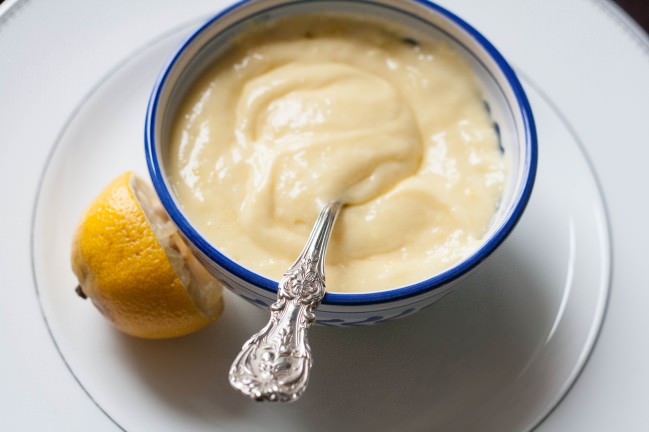 Ah Hollandaise Sauce, so simple, yet so tricky. Why do you tempt us so with your lemon butter goodness and very few ingredients only to break and curdle and overcook? Don’t worry, I have a few tips that make making Hollandaise Sauce go smoothly (pun intended) that I’ve learned along the way. “The way” meaning years of running out to the market for another dozen eggs at the last minute before I got it right, so now, you won’t have to head out on in the cold for a perfect Hollandaise Sauce for your brunching needs.
Ah Hollandaise Sauce, so simple, yet so tricky. Why do you tempt us so with your lemon butter goodness and very few ingredients only to break and curdle and overcook? Don’t worry, I have a few tips that make making Hollandaise Sauce go smoothly (pun intended) that I’ve learned along the way. “The way” meaning years of running out to the market for another dozen eggs at the last minute before I got it right, so now, you won’t have to head out on in the cold for a perfect Hollandaise Sauce for your brunching needs.
Makes 1 ½ cups
3 yolks
1 tablespoon cold water
salt
cayenne or paprika
⅓ cup clarified butter
8 tablespoons cold unsalted butter
1-3 tablespoons lemon juice
Okay. So after reading MANY Hollandaise recipes over the years, I finally figured out what the water bath and the double boiler techniques are really all about: temperature control. Eggs scramble quickly. And since I don’t use water baths or double boilers very often, that’s not actually the best way for ME to have control of the temperature. So I make Hollandaise over the stove in my smallest pot. I also keep a bowl of room temperature water near by in case I need to cool down the sauce quickly. Next, why does Hollandaise vary so much? I mean, it’s so few ingredients. What are people doing to it? Why is some runny and some thick and rich? (For the record, I like thick and rich). Here’s the deal: butter is about 20% water and milk solids. The rest is fat, so if you’re using only regular butter, like most home cook recipes do, when the butter breaks down (as you heat it) the water and milk solids make the sauce runny. If you look at a lot of professional recipes, you’ll see they call for clarified butter. This is really helpful for getting the Hollandaise thick and rich, but then you lose the awesome creamy taste that regular butter brings to the table. I recommend a half and half approach. Finally, it’s important to remember think about where things go wrong. First hard part? Getting eggs and water to emulsify. They don’t like mixing. We’re making them. They resist. This challenge is easily overcome by more whisking. Second hard part? Not scrambling the yolks. Keep it cool, slow it down, whisk a lot. Third hard part? Second emulsification. Eggs and lemons don’t like to mix. We’re making them. But fortunately, we’ve made them more stable with lots and lots of butter. Okay, pep talk over, here we go.
In a small heavy sauce pan, combine yolks, cold water, a little salt and a tiny bit of pepper (I like cayenne). 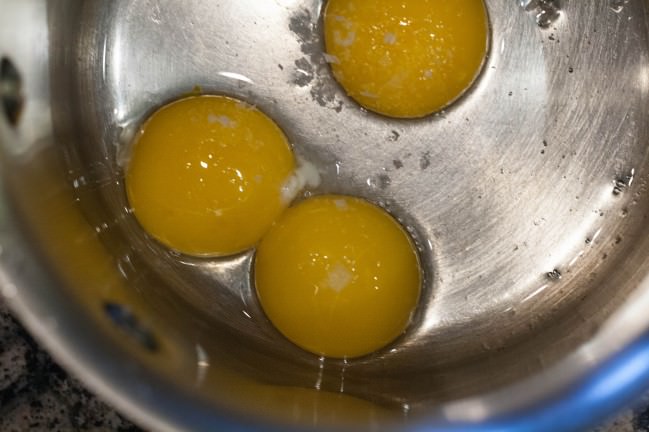 Whisk well (I chose to use a handheld mixer for all of this, because I didn’t want my arm to get sore and I like a lot of whisking). Over low heat, whisk in about half of the clarified butter.
Whisk well (I chose to use a handheld mixer for all of this, because I didn’t want my arm to get sore and I like a lot of whisking). Over low heat, whisk in about half of the clarified butter. 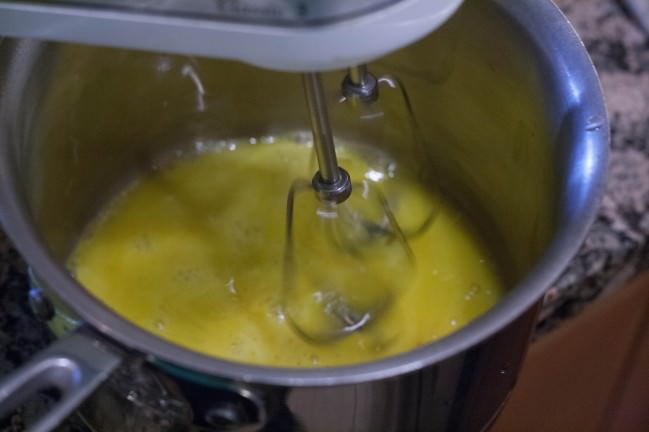 When it starts to thicken, add the rest of the clarified butter.
When it starts to thicken, add the rest of the clarified butter. 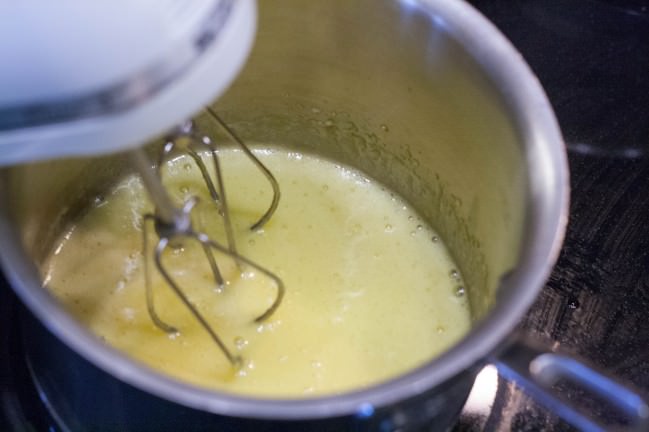 When it thickens again, start to whisk in the cold unsalted butter. At any point that you feel you have a good handle on the temperature, you can ooch it up a little hotter. If you feel like it’s getting away, remove the pot from the heat and slow the cooking in your bowl of water. When you’re a pro, you can graduate yourself to a higher temperature, or a water bath or double boiler. And if you do scramble the eggs, just start over. There’s no saving them. When the sauce is thick and smooth, whisk in the lemon juice.
When it thickens again, start to whisk in the cold unsalted butter. At any point that you feel you have a good handle on the temperature, you can ooch it up a little hotter. If you feel like it’s getting away, remove the pot from the heat and slow the cooking in your bowl of water. When you’re a pro, you can graduate yourself to a higher temperature, or a water bath or double boiler. And if you do scramble the eggs, just start over. There’s no saving them. When the sauce is thick and smooth, whisk in the lemon juice. 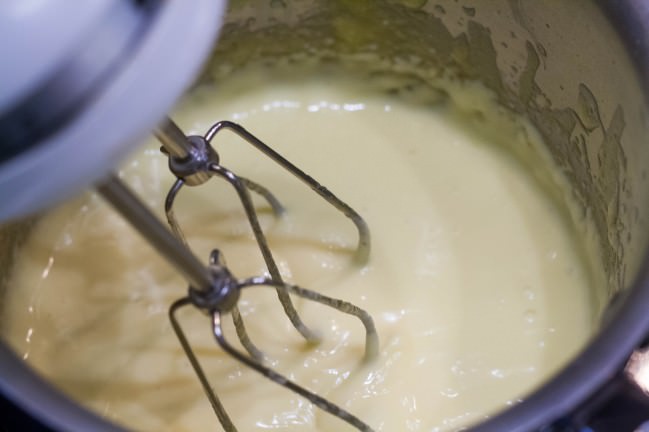 I like a lot of lemon. You can taste as you add and figure out what you like. You can make this a day ahead and rewarm very gently (actually, a water bath is great for this). It won’t be as voluminous as just made sauce though. Pour the warm sauce over poached eggs and hot English muffins. We’re making Eggs Benedict of course.
I like a lot of lemon. You can taste as you add and figure out what you like. You can make this a day ahead and rewarm very gently (actually, a water bath is great for this). It won’t be as voluminous as just made sauce though. Pour the warm sauce over poached eggs and hot English muffins. We’re making Eggs Benedict of course. 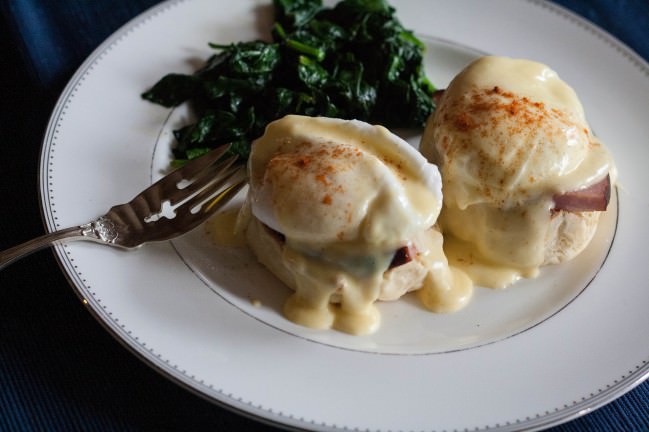

Pingback: Blue Ridge Mountain Benedicts | Dirty Laundry Kitchen